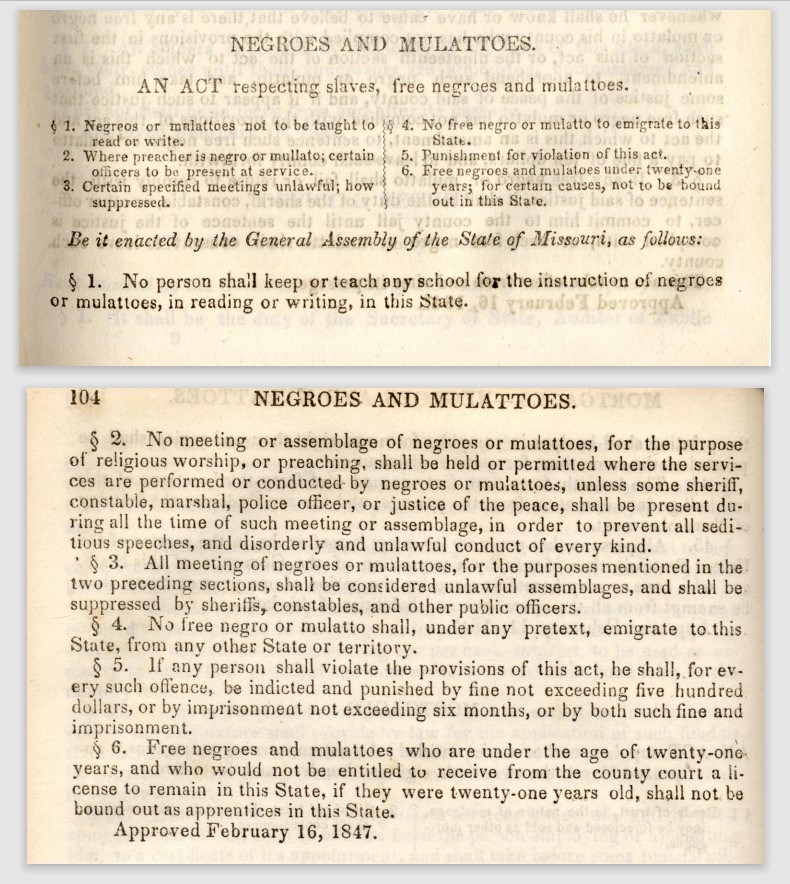Part of a series of articles titled The History of Slavery in St. Louis.
Article
Further Reading on Slavery in St. Louis and Missouri

Missouri State Archives
Primary Sources
- 1825, "An Act Directing the County Courts to Appoint [Slave] Patrols."
- 1835, "An Act Concerning Free Negroes and Mulattoes."
- 1836 Missouri State Law outlining punishments for enslaved people convicted of a crime
- 1837 Missouri State Law banning abolitionist materials
- 1845, "An Act Concerning Free Negroes and Mulattoes."
- 1845, "An Act Concerning [Slave] Patrols."
- 1847 Missouri State Law banning the teaching of reading and writing to Black Missourians
- Henry Clay Bruce, The New Man: Twenty-Nine Years a Slave, Twenty-Nine Years a Free Man
- Civil War on the Western Border, “Suggested Primary Sources for Teachers and Students”
- Lucy Delaney, From the Darkness Cometh the Light, or Struggles for Freedom
- Documenting the South, The Writings of William Wells Brown
- Gilder Lehrman Institute of American History, “Runaway Slave Ad, 1852”
- Mattie J. Jackson, The Story of Mattie J. Jackson
- Elizabeth Keckley, Behind the Scenes, or, Thirty Years a Slave, and Four Years in the White House
- Missouri State Archives, “Primary Source Documents at the Missouri State Archives Pertaining to Slavery in Missouri.
- ”Missouri State Archives, “State of Missouri vs. Celia, A Slave” (see McLaurin book below for overview of case)
- Missouri State Parks, “Interviews with Former Missouri Slaves”
- Reciept from Bernard Lynch, Bounty Hunter, to Henry Shaw for tracking and return of escape enslaved woman Sarah and her child, dated June 17, 1854.
- Receipt from Bernard Lynch, Bounty Hunter, to Henry Shaw for $100 itemizing costs incurred to capture enslaved woman Esther in Illinois and return her to St. Louis, dated May 21, 1855.
- James Shannon (former President of the University of Missouri), “An Address Delivered Before the Proslavery Convention of the State of Missouri, Held in Lexington, July 13, 1855, on Domestic Slavery, as Examined in the Light of Scripture, of Natural Rights, of Civil Government, and the Constitutional Power of Congress”
- State Historical Society of Missouri, “Missouri Slavery Documents”
- Benjamin F. Stringfellow, “Negro Slavery, No Evil”
Secondary Sources
- Kevin D. Butler, Slavery, Religion, and Race in Antebellum Missouri: Freedom from Slavery and Freedom from Sin (Washington, D.C.: Lexington Books, 2023)
- Gerald Early, ed. “Ain’t But a Place”: An Anthology of African American Writings About St. Louis (St. Louis: Missouri Historical Society Press, 1999)
- Kristen Epps, Slavery on the Periphery: The Kansas-Missouri Border in the Antebellum and Civil War Eras (Athens: University of Georgia Press, 2016)
- Lorenzo J. Greene, Gary R. Kremer, and Antonio Holland, eds., Missouri’s Black Heritage (Columbia: University of Missouri Press, 1993 [revised edition])
- Louis Gerteis, Civil War St. Louis (Lawrence: University of Kansas Press, 2001)
- Douglas R. Hurt, Agriculture and Slavery in Missouri’s Little Dixie (Columbia: University of Missouri Press, 1992)
- Bryan M. Jack, The St. Louis African American Community and the Exodusters (Columbia: University of Missouri Press, 2008)
- Ebony Jenkins, "Freedom Licenses in St. Louis City and County, 1835-1865." National Park Service, Gateway Arch National Park, 2008.
- Deborah Keating, “Spotswood Rice,” Civil War on the Western Border, 2011
- Kelly Kennington, In the Shadow of Dred Scott: St. Louis Freedom Suits and the Legal Culture of Slavery in Antebellum Missouri (Athens: University of Georgia Press, 2017)
- Gary R. Kremer, James Milton Turner and the Promise of America (Columbia: University of Missouri Press, 1991)
- Melton A. McLaurin, Celia, A Slave: A True Story of Violence and Retribution in Antebellum Missouri (Athens: University of Georgia Press, 1991)
- Missouri State Archives, “Missouri’s Early Slave Laws: A History in Documents”
- Missouri State Archives, “Laws Concerning Slavery in Missouri: Territorial to 1850s”
- Missouri Slave Narratives: Slave Narratives from the Federal Writers’ Project, 1936-1938 (Carlisle, MA: Applewood Books, 2006)
- Diane Mutti Burke, On Slavery’s Border: Missouri’s Small Slaveholding Households, 1815-1865 (Athens: University of Georgia Press, 2010)
- National Park Service, “Slavery: Cause and Catalyst of the Civil War”
- Matthew Pinsker, “Slave Stampedes and the Meaning of Mobile Insurrections”
- Sharon Romeo, Gender and the Jubilee: Black Freedom and the Reconstruction of Citizenship in Civil War Missouri (Athens: University of Georgia Press, 2010)
- Nick Sacco, “Missouri Compromised: Anti-Slavery Protest During the Missouri Statehood Debate,” Journal of the Civil War Era, March 10, 2020
- Eric Sandweiss, ed., St. Louis in the Century of Henry Shaw (Columbia: University of Missouri Press, 2003)
- Paul Simon, Freedom’s Champion: Elijah Lovejoy (Carbondale: Southern Illinois University Press, 1994)
- Jeffrey C. Stone, Slavery, Southern Culture, and Education in Little Dixie, Missouri, 1820-1860 (New York: Routledge, 2012)
- Anne Twitty, Before Dred Scott: Slavery and Legal Culture in the American Confluence, 1787-1857 (Cambridge: Cambridge University Press, 2016)
- Lea VanderVelde, Mrs. Dred Scott: A Life on Slavery’s Frontier (New York: Oxford University Press, 2009)
- Washington University in St. Louis University Libraries, “Select Readings on Enslavement in St. Louis and Missouri
Last updated: November 6, 2024
